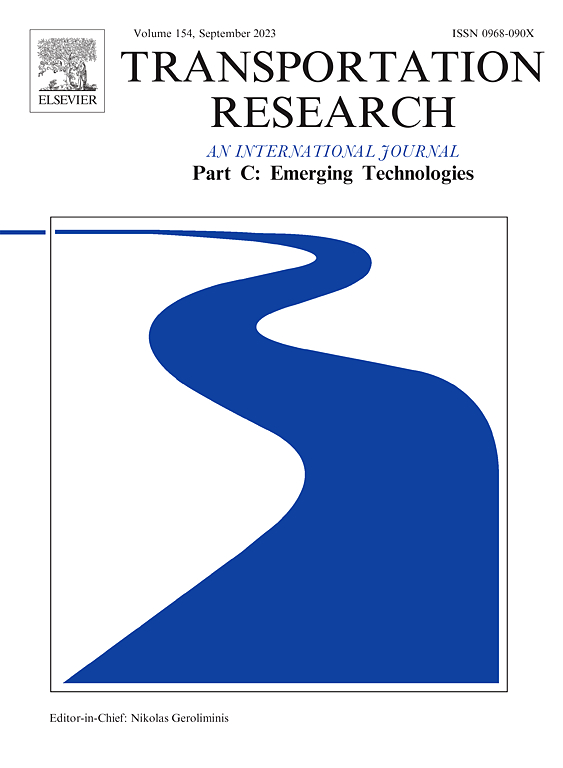A link-based flow model with turn-level queue transmission and time-varying free-flow speed for urban road networks
IF 7.6
1区 工程技术
Q1 TRANSPORTATION SCIENCE & TECHNOLOGY
Transportation Research Part C-Emerging Technologies
Pub Date : 2024-11-21
DOI:10.1016/j.trc.2024.104937
引用次数: 0
Abstract
Macroscopic link-based flow models are efficient for simulating flow propagation in urban road networks. Existing link-based flow models described traffic states of a link with two state variables of link inflow and outflow and assumed homogeneous traffic states within a whole link. Consequently, the turn-level queue length change within the link cannot be captured accurately, resulting in underrepresented queue spillback. Moreover, a constant link free-flow speed was assumed to formulate models, restricting their applicability in modeling phenomena involving time-varying free-flow speed. This study proposed a new link-based flow model by introducing an additional state variable of link queue inflow and adapting the link outflow to be free-flow speed-dependent. In our model, the vehicle propagation within each link is described by the link inflow, queue inflow, and outflow, which depends on the link free-flow speed changes and signal control. A node model is further defined to capture the presence of potential queue spillback, which estimates the constrained flow propagation between adjacent road segments. Simulation experiments were conducted on a single intersection and on networks to verify the proposed model performance. Results demonstrate the predictive power of the proposed model in simulating traffic proppagations for networks with multiple turning movements and time-varying free-flow speed. Our model outperforms the baseline link-based flow model while preserving the computational tractability property of link-based flow models.
基于链路的城市路网流量模型,包含转弯级队列传输和时变自由流速度
基于链路的宏观流量模型可有效模拟城市道路网络中的流量传播。现有的基于链路的流量模型使用链路流入和流出两个状态变量来描述链路的交通状态,并假设整个链路内的交通状态是同质的。因此,无法准确捕捉到链路内转弯层队列长度的变化,导致队列溢出反映不足。此外,在建立模型时假定链路自由流速度恒定不变,这限制了模型在涉及时变自由流速度现象时的适用性。本研究通过引入额外的链路队列流入状态变量,并将链路流出量调整为与自由流速度相关,提出了一种新的基于链路的流量模型。在我们的模型中,车辆在每个链路内的传播由链路流入量、队列流入量和流出量描述,而链路流入量、队列流入量和流出量取决于链路自由流速度变化和信号控制。我们还进一步定义了一个节点模型,以捕捉潜在的队列回溢,从而估算相邻路段之间受限的车流传播。我们在单个交叉口和网络上进行了仿真实验,以验证所提模型的性能。结果表明,在模拟具有多个转弯动作和时变自由流速度的网络的交通传播时,所提出的模型具有很强的预测能力。我们的模型优于基于链路的基准流量模型,同时保留了基于链路的流量模型的可计算性。
本文章由计算机程序翻译,如有差异,请以英文原文为准。
求助全文
约1分钟内获得全文
求助全文
来源期刊
CiteScore
15.80
自引率
12.00%
发文量
332
审稿时长
64 days
期刊介绍:
Transportation Research: Part C (TR_C) is dedicated to showcasing high-quality, scholarly research that delves into the development, applications, and implications of transportation systems and emerging technologies. Our focus lies not solely on individual technologies, but rather on their broader implications for the planning, design, operation, control, maintenance, and rehabilitation of transportation systems, services, and components. In essence, the intellectual core of the journal revolves around the transportation aspect rather than the technology itself. We actively encourage the integration of quantitative methods from diverse fields such as operations research, control systems, complex networks, computer science, and artificial intelligence. Join us in exploring the intersection of transportation systems and emerging technologies to drive innovation and progress in the field.

 求助内容:
求助内容: 应助结果提醒方式:
应助结果提醒方式:


